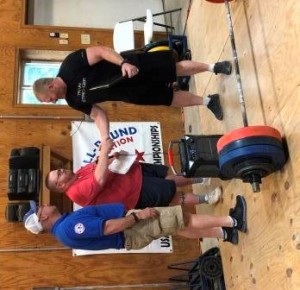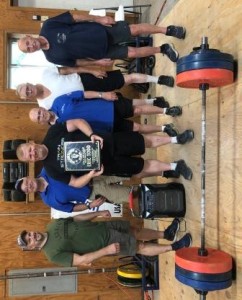By Dan Wagman, PhD, CSCS
The Strongest All Round Weightlifters in History
Ranking the most weight ever lifted and naming names
All-round weightlifting contests strength in lifts originating from the days of the old-time strongman and often referred to as odd lifts. For each of way over 200 tests of strength records are kept for women and men in age categories of Junior, Senior, Open, and Masters and weight classes starting at 30 kg (66 lbs.) for Juniors and increasing in 5 kg (11 lbs.) increments. However, the sport also values the overall greatest amount of weight lifted for an exercise in each weight class for men and women regardless of age called the “All” category. I decided to take it one step farther by looking at which athletes lifted the most weight ever in a given lift regardless of weight class and in how many lifts they had done so. The analysis is based on the USAWA Records List dated March, 2021. I thought it best to go from general/overall to specifics in highlighting the strongest strength athletes America has ever seen.
The Overall Strongest All-Rounders
My first step was to ascertain which lifters, regardless of gender, lifted the most weight ever and in how many different lifts they had accomplished that feat. Of note, rarely several athletes lifted the same amount of weight in a given exercise for an overall all-time record. When that occurred the exercise was counted multiple times and each athlete was added to the count. In the women’s ranks lifters set all-time records in 194 exercises while the men did so in 244.
I decided to take it one step farther by looking at which athletes lifted the most weight ever in a given lift regardless of weight class and in how many lifts they had done so.
Overall, in lifting the greatest amount of weight in 30 different lifts, the strongest all-rounder comes from the women’s ranks and is RJ Jackson. Eric Todd, having lifted the all-time greatest amount of weight in 27 different lifts, comes in second. He is followed by Mary McConnaughey and Dr. Al Myers who each established the greatest amount of weight ever lifted in 26 different lifts.
It is my belief that it would be difficult to argue against these lifters having established themselves as the four overall strongest people in the history of American strength sport. There have been claims made that other athletes in the heyday of strongman and strongwoman performers have exceeded these four’s number of record lifts. As an example, Hermann Görner is said to have set all-time records in hundreds of different lifts;2 one source even records “approximately 1,400 different feats of strength of all varieties.”1 It is important to note, however, that odd lifts in those days could not boast of standardized competition and equipment with established and uniform rules. Also, there were no concerted record keeping efforts supported by a well-established strength sport governing body such as USAWA. Therefore Jackson, Todd, McConnaughey, and Myers must be considered the greatest all-round strength athletes in the history of America…and perhaps beyond.
Jackson, Todd, McConnaughey and Myers must be considered the greatest all-round strength athletes in the history of America and perhaps beyond.
“All” Women
Let’s remain within the historical context for a moment. When thinking about old-time strongwoman performers names such as Katie Sandwina, Vulcana, and Minerva come to mind. Although these women were credited with some incredible lifts, each one excelled only at a few compared to today’s all-round weightlifters. This is illustrated no better than considering Jackson’s and McConnaughey’s overall ranking. And rounding out the top three women is Amorkor Ollennuking who is credited with an amazing 23 all-time and overall record shattering lifts.
Generally, observers tend to view strength sport form the perspective of lightweight and heavyweight competitors. I followed that lead and split the women’s weight classes roughly in half to highlight the lighter lifters’ accomplishments; the cutoff I selected was 80 kg (176 lbs). Because she’s a 50 kg (110 lbs) lifter, Jackson leads that category, too; Ollennuking comes in second as her all-time highest lift records were accomplished in the 75 kg (165 lbs) and 80 kg class. Beth Skwarecki’s strength propelled her in to third place with 11 all-time greatest records achieved at a body weight ranging from 60 kg (132 lbs) to 70 kg (154 lbs).
At 85 kg (187 lbs) to super heavyweight McConnaughey rules with Jera Kressly’s 9 all-time record-breaking lifts placing her second. Felecia Simms ranks third with 5 all-time records. In splitting the athletes into lighter and heavier groups, it seems worthwhile to ascertain which weight classes contain the strongest lifters. The super heavyweight class at greater than 125 kg (275 lbs) ranks number one with 37 all-time record lifts. That weight class is followed by the 50 kg class with 32 lifts and rounding out the top three is the 70 kg class with 29 different lifts.
Since all-round weightlifting as governed by USAWA has been around for over 25 years, the oldest still standing records date back to 1988. On February 6, Cindy Garcia set still-standing records in the bench press, roman chair and pinch grip deadlift, right hand of 45 and 90 lbs; respectively. That same day, but in a different weight class, Jo Schuster equaled Garcia’s pinch grip deadlift, right hand and that record remains as well. The second oldest and remaining all-time heaviest weight record was performed on August 27. Doris De La Rosa performed a 72 lbs clean and press, dumbbells, heels together. The next day garnered her another overall record that still stands—a 99 lbs jerk from rack, behind the neck.
“All” Men
Todd and Myers established themselves without doubt as the strongest all-round strength athletes in America. These two lifters, separated by only one lift, are closely followed by Kansas’ Chad Ullom who leads the count in setting all-time heaviest weights lifted in 20 different lifts. In breaking down the weight classes, it is worth noting that the super heavyweight class leads the men’s category with total all-time records in 51 different lifts. The 115 kg (253 lbs) weight class lifters rank second with the heaviest recorded lifts in 36 different exercises followed by the 110 kg (242 lbs) class with records in 34 different lifts.
It seems worthwhile to investigate which lifters weighing less than 200 lbs. were still able to hoist the most weight ever in a given lift.
Of note, throughout strength sport history many observers felt that male lifters up to and over 200 lbs should be separated. Considering that the top three men would be considered heavyweights, it seems worthwhile to investigate which lifters weighing less than 200 lbs were still able to hoist the most weight ever in a given lift. To do so, those lifters weighing up to 90 kg, i.e., 198 lbs, were analyzed. I have to admit that I was surprised to learn that I lead the under-200-pack with lifting the all-time greatest amount of weight in 6 different lifts. Bob Hirsh comes in second with having achieved the same feat in 4 different lifts. Stephen Santangelo and Abe Smith each set all-time heaviest weight lifted records in 3 different lifts and so share third place honors.
Who is the lightest lifter to have lifted more weight in an exercise than any other man?
In remaining within the theme of lighter men lifting the greatest amount of weight in certain exercises, an interesting question to ponder is: who is the lightest lifter to have lifted more weight in an exercise than any other man? His name is Mark Baldassarre and he did so at a body weight of 65 kg (143 lbs); he performed a 350-lbs bench dip.
Finally, which lifters hold the oldest all-time records? In the 100 kg (220 lbs) weight class Steve Schmidt does so with a 270 lbs pullover and press with a bridge set September 20, 1987. In the super heavyweight class Ken McClain’s record clean and press with dumbbells and heels together of 240 lbs is dated November 7, 1987. The next day Brent Pearce performed a continental to chest in the 65 kg (143 lbs) class with a remarkable 309 lbs.
A Different Sorta Animal
Like many aspects in life, strength sport has evolved over time. While the first modern Olympic Games included weightlifting, it only vaguely resembles today’s version of the sport. Back then lifters performed feats of strength in various different exercises. Today the sport of weightlifting only contests two lifts that both require the athlete to do but one thing—hoist a loaded barbell overhead. The sport of powerlifting is much newer to the strength-sport scene and requires athletes to lift maximal weight in the squat, bench press, and deadlift. With three instead of just two lifts, to include very different exercises, powerlifting offers a greater scope of testing overall strength than weightlifting. But considering the “parent” strength sport of strongman and strongwoman, both pale in comparison when seeking to establish a person’s overall maximal strength. With that purpose in mind, all-round weightlifting ranks supreme and the athletes highlighted here must therefore be considered the overall strongest people our country has produced.
All-round weightlifting should not, however, only be judged in that regard—producing the overall strongest athletes. Every other strength sport requires athletes to perform a very limited number of exercises that can therefore be trained to perfection. All-round weightlifting on the other hand tests strength in such a variety of different exercises that few, if any of them, can be trained to the same level of perfection as those contested in weightlifting and powerlifting. In addition, where weightlifting and powerlifting can self-select top performers who naturally excel in the few contested lifts, that is not the case in all-round weightlifting. Even the strongest all-rounder will find him- or herself humbled by how weak they are in some exercises. But to the credit of most all-rounders, they train and perform those exercises on a platform anyway. They put themselves out there. And so beyond deserving an immense level of respect and recognition for their strength, the athletes highlighted in this article also deserve reverence for their willingness to challenge themselves in areas other strength sports and athletes dare not to. Let’s hope the sport’s leadership keeps this—the greatest strength sport in history—alive by actively promoting it to the younger generation. It would be a tragedy if this sport would end up going the route of the circus strongman.
References
- Mueller, E. Goerner the Mighty. Vulcan Publishing, 1951.
- Willoughby, D. The Super Athletes. A.S. Barnes & Co., 1970.

